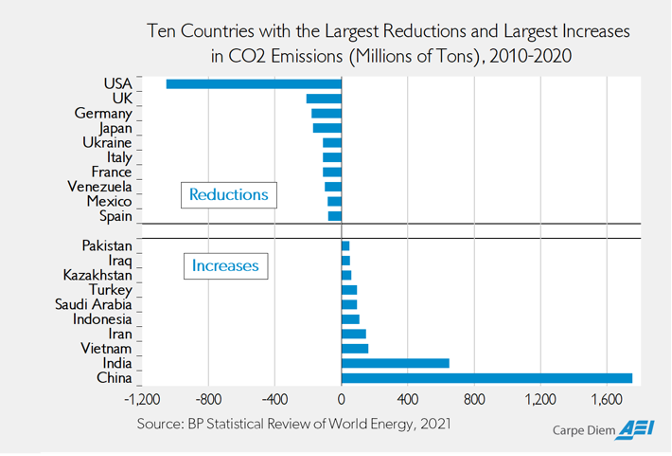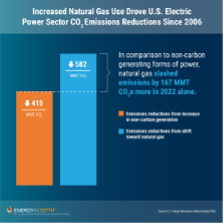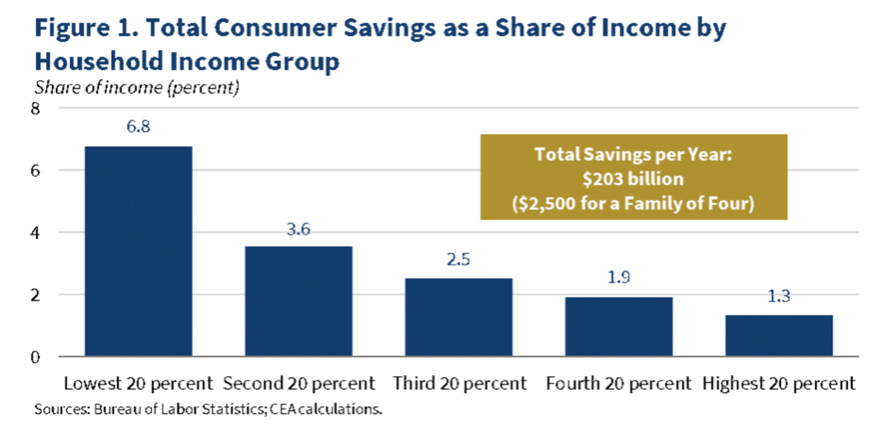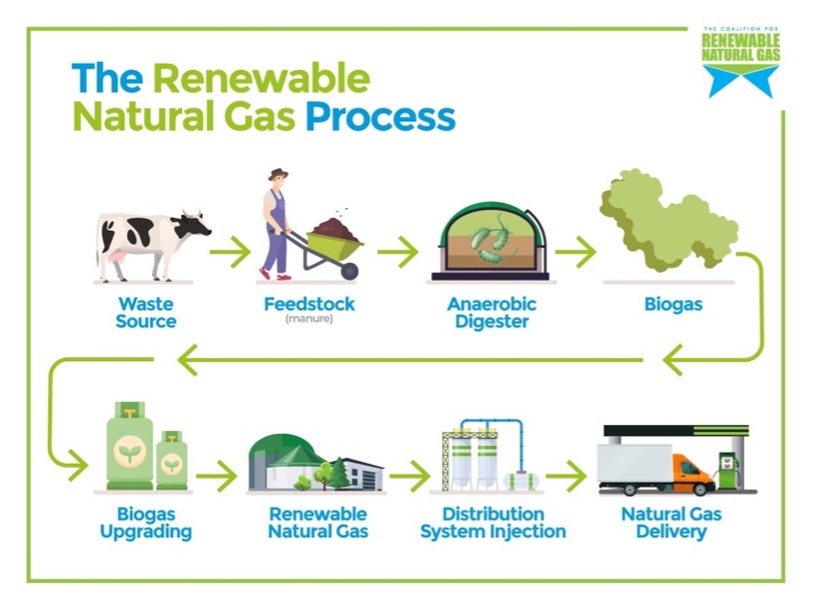Learn

RESEARCH & DATA
TEA Factsheet: Common Sense Energy Agenda
1. Recognize natural gas is green. Why it matters: American natural gas is affordable, clean, abundant, and reliable energy that improves the environment while securing American energy independence. It is the green bridge to a future of alternative sources of affordable, clean, and reliable energy.
Since 1970, combined emissions of key pollutants have dropped by 78% in the U.S. “Since 1970, implementation of the Clean Air Act and technological advances from American innovators have dramatically improved air quality in the U.S. Since that time, the combined emissions of criteria and precursor pollutants have dropped by 78%.” (“Our Nation’s Air: Trends Through 2022,” Environmental Protection Agency, 2023)
The U.S. is a world leader in lowering carbon emissions, largely because of increased use of natural gas for electricity generation.
(Mark Perry, “Some Charts and Commentary Based on BP’s Annual Report on World Energy Statistics,” American Enterprise Institute, 7/9/21; “BP Statistical Review of World Energy,” BP, 2022)

(Mark Perry, “Some Charts and Commentary Based on BP’s Annual Report on World Energy Statistics,” American Enterprise Institute, 7/9/21)
In 2022 alone, the shift to natural gas provided an emissions reduction equivalent to 156 coal-fired power plants operating for a year. (Mandi Risko, “Natural Gas Is, Once Again, Spearheading Emission Reductions Across The U.S. Power Sector,” Energy In Depth, 11/30/23)
Since 2005, natural gas used for power generation has cut nearly double the emissions that renewable sources like wind and solar have. (Mandi Risko, “Natural Gas Is, Once Again, Spearheading Emission Reductions Across The U.S. Power Sector,” Energy In Depth, 11/30/23)

(Mandi Risko, “Natural Gas Is, Once Again, Spearheading Emission Reductions Across The U.S. Power Sector,” Energy In Depth, 11/30/23)
2. Secure America’s energy independence with natural gas and make the world safer. Why it matters: Energy is essential to life and the well-being of everyone. Countries and their citizens are held hostage to energy supplies from countries with bad intent. The more America powers the world, the more secure the world will be for all freedom-loving people.
Years ago, the U.S. surpassed Russia and Saudi Arabia to become the world’s top producer of natural gas and oil largely because of the U.S. shale revolution. (“The U.S. Leads Global Petroleum And Natural Gas Production With Record Growth In 2018,” U.S. Energy Information Administration, 8/20/19; “What countries are the top producers and consumers of oil?,” U.S. Energy Information Administration, Updated 5/1/23)
(“United States continued to lead global petroleum and natural gas production in 2020,” U.S. Energy Information Administration, 7/19/21)
According to the International Energy Agency, China controls 87% of global rare earths refining capacity. “Technical complexities, partnership strains and pollution concerns are hampering companies’ ability to wrest market share away from China, which according to the International Energy Agency controls 87% of global rare earths refining capacity.” (Ernest Scheyder and Eric Onstad, “Insight: World battles to loosen China’s grip on vital rare earths for clean energy transition,” Reuters, 8/2/23)
- Rare earth metals are necessary to build batteries and other technologies for electric vehicles and renewable energy sources like, wind and solar power. (James MacDonald, “The Downside To Renewable Energy, JSTOR Daily, 5/6/19; “U.S. Dependence On China’s Rare Earth: Trade War Vulnerability,” Reuters, 6/27/19)
Prior to the invasion of Ukraine, Russia was the largest natural gas exporter to Europe. “The share of Russia’s pipeline gas in EU imports dropped from over 40% in 2021 to about 8% in 2023. For pipeline gas and LNG combined, Russia accounted for less than 15% of total EU gas imports. The drop was possible mainly thanks to a sharp increase in LNG import and an overall reduction of gas consumption in the EU.” (“Infographic – Where does the EU’s gas come from?,” Council of the European Union, Updated 2/19/24)
But, by 2023, the U.S. was the second largest supplier of natural gas to Europe. “Norway and the United States were the top suppliers of gas in 2023. Norway provided almost 30% of all gas imports. Additional suppliers include North African countries, the UK and Qatar.” (“Infographic – Where does the EU’s gas come from?,” Council of the European Union, Updated 2/19/24)
3. Encourage states to prohibit natural gas bans. Why it matters: Access to abundant and reliable natural gas is essential to affordable energy for everyday Americans and small businesses. Affordable energy is critical to returning manufacturing and good-paying jobs to America.
Dozens of cities in California, as well as other cities on the West Coast and in the Northeast U.S., have advanced some form of ban on natural gas use in buildings. “The movement to ban natural gas use in buildings reached a milestone in the second half of 2021, with California notching its 50th building electrification mandate. Meanwhile, the number of states prohibiting the policy appeared poised to top out around 20 this year, as all-electric construction ordinances advanced on the East and West coasts and cropped up in Oregon.” (Tom DiChristopher, “Gas Ban Monitor: Calif. count reaches 50 as West Coast movement grows,” S&P Global Market Intelligence, 11/23/21)

(Tom DiChristopher, “Gas Ban Monitor: 1st Mass. bans advance amid broader New England push,” S&P Global Market Intelligence, 11/8/23)
On the other hand, sensible states around the country have passed legislation to keep these municipal bans from being put in place. “A firewall that preserves access to natural gas now stretches from Idaho to New Hampshire and Arizona to Florida, with only a few states across the interior US allowing gas bans. At least 24 states have passed laws that prohibit local governments from restricting gas use in buildings, according to a review of state legislation by S&P Global Commodity Insights. The passage of four bills in the first half of 2023 broke a dry spell of more than one year for the legislation, dubbed energy choice laws by their backers.” (Tom DiChristopher, “Half of US states are on pace to prohibit local gas bans,” S&P Global Market Intelligence, 6/21/23)
4. Build more natural gas and energy pipelines. Why it matters: Pipelines are the safest, most environmentally sound, and efficient way to transport energy. A country without pipelines is like a body without veins.
The U.S. “has the largest network of pipelines in the world” with millions of miles stretching across the U.S. delivering fuel to individual and business consumers. “The U.S. has the largest network of pipelines in the world. Millions of miles of pipeline thread their way across the United States, creating a transportation system that delivers fuels and feedstocks that American consumers, businesses, and manufacturers use daily.” (“Pipelines Power America,” Global Energy Institute, Accessed 2/19/24)
According to the U.S. Pipeline and Hazardous Materials Safety Administration, pipeline systems are the safest means to move oil and gas products. “Pipeline systems are the safest means to move these products. The federal government rededicated itself to pipeline safety in 2006 when the PIPES Act was signed. It mandates new methods and makes commitments for new technologies to manage the integrity of the nation’s pipelines and raise the bar on pipeline safety.” (“General Pipeline FAQs,” U.S. Department of Transportation, Pipeline and Hazardous Materials Safety Administration, Updated 11/6/18)
Pipelines are guided by state and federal regulation that ensures “the safety of the design, operation, maintenance, and emergency response of oil and natural gas pipelines and facilities.” “State and federal government regulatory processes guide the construction and safe use of oil and gas pipelines. Regulations ensure the safety of the design, operation, maintenance, and emergency response of oil and natural gas pipelines and facilities. Processes are in place to provide for the proper siting, planning, and public and stakeholder input and review of pipeline projects prior to construction.” (“Pipelines Power America,” Global Energy Institute, Accessed 2/19/24)
A study by the Consumer Energy Alliance found that more than 66,000 jobs, $13.6 billion in investments, and more than $280 million per year in state and local tax revenue have been canceled or are at risk of being lost as a result of delayed pipeline projects. “Activists, litigation and permit delays have canceled or are threatening a minimum of $13.6 billion in economic activity, the creation and support of over 66,000 jobs and more than $280 million per year in state and local tax revenue just by targeting the pipeline projects in this report. Further, untold billions in cumulative consumer savings are being put at risk or have been permanently lost during an economic downturn simply because certain policymakers, regulators and even jurists will not approve pipelines.” (“How Pipelines Can Spur Immediate Post-Covid Economic Recovery,” Consumer Energy Alliance, 9/10/20)
5. Promote natural gas as a green energy source in all appropriate applications. Why it matters: The United States is the world leader in clean air quality thanks to natural gas. Imagine if natural gas was used for transportation fuel, heated every home, and used to produce more electricity; the environment would be substantially improved while not wreaking havoc on our economy.
A report from the Council of Economic Advisers found that price decreases that resulted from the American shale revolution have saved an average family of four $2,500 a year—that’s a $203 billion annual savings for U.S. consumers. (“The Value of U.S. Energy Innovation and Policies Supporting the Shale Revolution,” The Council of Economic Advisers, 10/19)

(“The Value of U.S. Energy Innovation and Policies Supporting the Shale Revolution,” The Council of Economic Advisers, 10/19)
Households that use natural gas for heating, cooking and other appliances save an average $1,068 per year compared to homes using electricity for such appliances. (“Affordable,” American Gas Association, Accessed 2/19/24)
A study by the National Bureau of Economic Research concluded that “the drop in natural gas prices in the late 2000s, induced largely by the boom in shale gas production, averted 11,000 winter deaths per year” in the United States. (Janjala Chirakijja, Seema Jayachandran and Pinchuan Ong, “Inexpensive Heating Reduces Winter Mortality,” National Bureau Of Economic Research, 3/19)
6. Unleash the power of liquified natural gas (LNG) to support our allies, stabilize world energy markets and improve the global environment. Why it matters: Natural gas is pound-for-pound the greenest fuel on earth. America has the largest supply of natural gas in the world…enough to power our own needs and our allies for a century. Building more terminals and exporting this green energy ensures economic growth, improving the environment, security and prosperity around the world.
“The U.S. liquefied natural gas (LNG) industry has provided secure, stable and reliable natural gas to our trading partners in Europe since we began exporting in 2016.” (“U.S. LNG Exports: Delivering Certainty in Time of Crisis,” Center for Liquefied Natural Gas, Accessed 2/19/24)
In 2023, the U.S. was the largest exporter of LNG in the world. “U.S. liquefied natural gas exports hit monthly and annual record highs in December, tanker tracking data showed, with analysts saying it positioned the United States to leapfrog Qatar and Australia to become the largest exporter of LNG in 2023.” (“US was top LNG exporter in 2023 as hit record levels,” Reuters, 1/3/24)
According to the Center for Liquid Natural Gas, “Secure, reliable U.S. liquefied natural gas (LNG) is playing a critical role in stabilizing global energy markets, especially those in Europe.” (“U.S. LNG Exports: Regulatory Certainty in Time of Crisis,” Center for Liquefied Natural Gas, Accessed 2/19/24)
7. Lead the world in renewable natural gas technologies. Why it matters: We generate garbage and wastewater every day, and lots of it. Cost effective capture and use of the emissions and unpleasant smells we all know well from landfills, water treatment plants, animal waste, and other sources is a real gain toward meaningful environmental activism.
Renewable Natural Gas (RNG) is a clean, affordable and reliable waste-derived fuel that can be used to power homes, businesses and even vehicles. “Renewable Natural Gas (RNG) is, by definition, a clean, affordable and reliable waste-derived fuel that can be used to power homes, businesses and even vehicles. How does it work? Every community in America produces waste. As that waste breaks down, it emits methane, which is a naturally occurring, but potent and harmful greenhouse gas (GHG). RNG projects capture this methane from existing food waste, animal manure, wastewater sludge and garbage, and redirect it away from the environment, repurposing it as a clean, green energy source. Made from matter that is already decomposing right under our feet, RNG is the product of pure innovation and ingenuity.” (Renewable Natural Gas, Coalition For Renewable Natural Gas, Accessed 2/19/24)
“As a storable, replenishable fuel that looks and acts like natural gas, RNG provides a practical, cost-efficient and reliable energy solution.” “As a storable, replenishable fuel that looks and acts like natural gas, RNG provides a practical, cost-efficient and reliable energy solution – and it is available today! Hundreds of farms, businesses and residents are already using it. RNG is not only helping slow the impacts of climate change in the near-term, it is also helping to rebuild local economies for the future.” (Renewable Natural Gas, Coalition For Renewable Natural Gas, Accessed 2/19/24)

(Renewable Natural Gas Infographics, Coalition For Renewable Natural Gas, Accessed 2/19/24)
“While other transportation decarbonization solutions will take years to realize, RNG projects quickly demonstrate results.” “Currently, RNG is primarily used as a substitute for conventional natural gas which itself is a substitute for diesel in heavy-duty vehicles like semis. While electric cars are now a viable, clean-energy solution, heavy-duty trucks will take longer to successfully electrify, making RNG a good fuel for near-term decarbonization in large vehicles. While other transportation decarbonization solutions will take years to realize, RNG projects quickly demonstrate results.” (Beth Burmahl, “Turning waste to energy: tracking renewable natural gas transportation projects,” Argonne National Laboratory, 4/12/22)
There are 311 operational RNG facilities in the U.S. and Canada. Another 489 are either being planned or currently under construction (Renewable Natural Gas Infographics, Coalition For Renewable Natural Gas, Accessed 2/19/24)

(Renewable Natural Gas Infographics, Coalition For Renewable Natural Gas, Accessed 2/19/24)
8. Expand energy technical trades education and training programs. Why it matters: America’s energy industry is a source of good-paying jobs. To realize affordable energy independence we need to fill thousands of jobs waiting for Americans to roll up their sleeves and get to work. Education, training, and the upskilling of American workers will impact positively millions of our families, friends and communities directly and ultimately every American will benefit through a prosperous economy fueled by affordable energy.
The U.S. oil and natural gas industry supports 10.9 million American jobs. (“Powering the Workforce of the Future,” American Petroleum Institute, Accessed 2/19/24)
American businesses have saved $500 billion over the last decade because of affordable natural gas, allowing them to invest more in growth and job creation. (“AGA Playbook,” American Gas Association, 2023)
A July 2020 survey of “both union and non-union” tradespeople reported that oil and gas jobs “have better wages, benefits and opportunities than renewables projects.” “In July the NABTU—whose affiliates include the Teamsters and International Brotherhood of Electrical Workers—released two surveys of workers and statistics that analyze jobs across the energy economy. They found that ‘both union and non-union’ tradespeople report that oil and gas jobs ‘have better wages, benefits and opportunities than renewables projects.’” (Editorial, “About Joe’s Energy Jobs,” The Wall Street Journal, 8/24/20)
According to the Bureau of Labor Statistics the oil and gas industry provides an average annual salary of $108,000, “nearly twice the private economy average” and can be even higher at large companies like Exxon Mobil, where median worker pay is about $170,000 a year. “The Bureau of Labor Statistics says the oil and gas industry provides an average annual salary of $108,000, nearly twice the private economy average. A Journal analysis last year found even higher average wages at large companies like Exxon Mobil, where median worker pay is about $170,000 a year.” (Editorial, “About Joe’s Energy Jobs,” The Wall Street Journal, 8/24/20)
North America’s Building Trades Unions (NABTU) president Sean McGarvey estimates that many union members would “take a 50% or 75% pay cut” if they changed jobs into the renewable energy industry. “Renewable medians are harder to measure, but NABTU president Sean McGarvey estimates that many union members would ‘take a 50% or 75% pay cut.’ In 2008 Barack Obama promised millions of ‘green jobs,’ but the great irony was that the oil-and-gas fracking revolution provided the real employment boom of his Presidency. According to a Bloomberg News analysis, the U.S. fossil fuels industry employs nearly five million people, including 250,000 in Pennsylvania, 174,000 in Ohio and 839,000 in Texas. Now Mr. Biden wants to extinguish those jobs on a bet on solar panels and wind turbines. As the union workers put it, c’mon, man.” (Editorial, “About Joe’s Energy Jobs,” The Wall Street Journal, 8/24/20)




